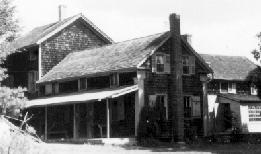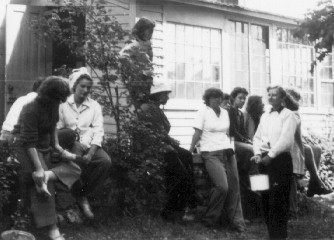

In 1890, the Northrops spent six months in the Bahamas collecting animal, plant, and mineral specimens. This was the most extensive survey ever undertaken of the natural history of the Bahamas. Many of these specimens can still be found today in museums around the world. When Alice finished her analysis of the botanical material ten years later, she had discovered eighteen new species.
In 1892, John I. Northrop was killed in a laboratory explosion. The Northrops' only child, a son, was born one week later. (The son, John H. Northrop, eventually followed in the footsteps of the father he never knew, and became one of the great chemists of the twentieth century. He was the first person to crystalize a protein and determine its structure by means of x-ray diffraction, and he won the Nobel prize for this work in 1946. This technique would prove crucial some years later, when Watson and Crick worked out the structure of DNA.)
By all accounts, Alice Rich Northrop was an inspiring teacher, and many of her students kept in touch with her for years after they graduated. A lot of these students became teachers in the New York City public schools, and they reported back to Mrs. Northrop about the conditions they encountered there. She became concerned about the fact that the public school curriculum included nothing of what was then called "nature study", and would now be called, loosely, "ecology" or "environmental science". Determined to correct this situation, she founded the School Nature League, with the object of establishing a nature room in every New York City public School. These nature rooms included terraria, and various preserved plants and stuffed animals. But eventually, Mrs. Northrop concluded that the rooms could not convey the full glory of the natural world to children who had spent their lives on the streets of New York. She decided that she had to bring the children out to the country.
In 1920, Alice Northrop bought a 150-year old farm house on 500 acres of land in the village of Mt. Washington, Massachusetts, right against the New York state line. She was familiar with the area because her sister had lived nearby for many years, and she intended to spend her summers there and perhaps live there year round after she retired. She named the estate High Meadows. With her colleagues Emilie Long and Mrs. Samuel Weiss, she made arrangements to bring a group of New York City school children up to the house for a week or two in the summer of 1922. But while driving up to High Meadows to make the final preparations, her car became stalled at a railroad crossing. She was hit by a train and killed instantly.

The grief-stricken friends of Mrs. Northrop, including many colleagues and students from Hunter College, pledged to make her dream a reality. They incorporated themselves as the Alice Rich Northrop Memorial and bought the house and grounds from Alice's son, John. The first group of twenty boys, ranging in age from 12 to 14, arrived in July 1923. They slept in tents and ate in the dining room of High Meadows. An old barn became the rec hall, a shed became the wash house. A second group of twenty boys spent the month of August at the camp. The following summer, two groups of twenty girls were there for a month each. 
The camp continued to operate without interruption for 71 years, taking about twenty children in July and another twenty in August, with boys and girls in alternating years (except during the Second World War, when there were two girls' years in a row, because it was impossible to hire male counselors). In addition to the usual camp activities -- hiking, swimming, softball, volleyball, campfires -- the children grow their own vegetables, collect and identify leaves and wildflowers, examine pond water under a microscope, learn the calls of birds, and look at the stars at night. Often they will take care of an animal for a few days -- a snake spotted in the grass, a fieldmouse rescued from the pool, a raccoon caught breaking into the cellar -- but these animals are always released unharmed.

During the 1960's the tents were replaced by cabins, and the old farmhouse was replaced by a modern structure, including flush toilets and hot showers, but the spirit of the camp remained unchanged. The requirements for admission have always been simple: Each child must attend public school in New York City, have parents who cannot afford a commercial summer camp, and have a strong interest in science and nature. Parents must pay a small fee ($15 in 1934, gradually growing to $120 by 1993) which covers only a small fraction of the camp's expenses, but no camper has ever been turned down for lack of money. The rest of the expenses are paid for by donations, at first by the friends of Alice Rich Northrop herself, and later by former campers who never knew Mrs. Northrop in the flesh, but who will always look back at Northrop Camp as a very special time of their lives.
or
We are trying to raise funds to rebuild the camp. If you would like to make a donation or have a skill you are willing to contribute (construction, fundraising, publicity, CPA, legal work, etc.), please contact Northrop or write to: